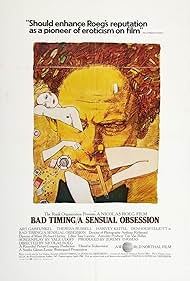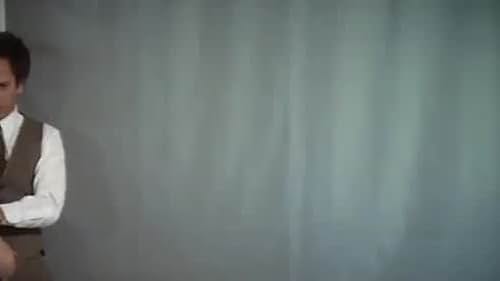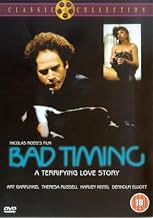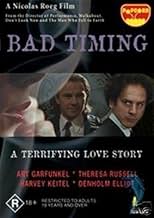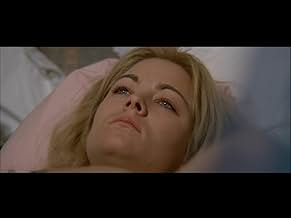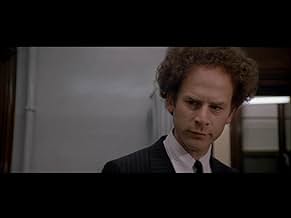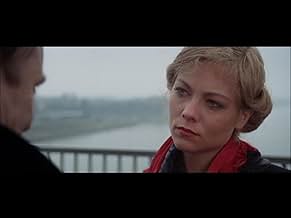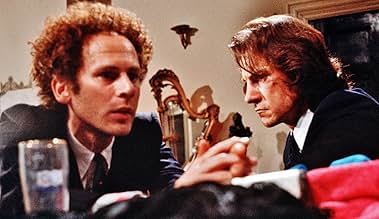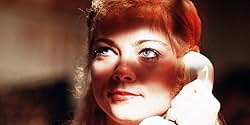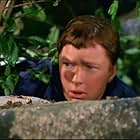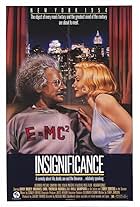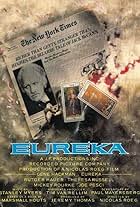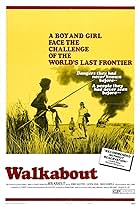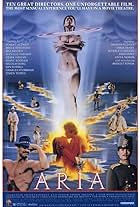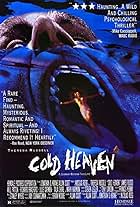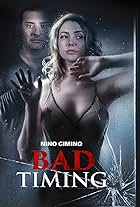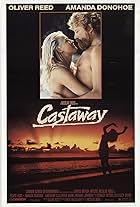VALUTAZIONE IMDb
6,9/10
9862
LA TUA VALUTAZIONE
Uno psichiatra residente a Vienna inizia una relazione difficile con una donna sposata. Quando finisce in ospedale per avvelenamento, un ispettore decide di scoprire di più sulla fine della ... Leggi tuttoUno psichiatra residente a Vienna inizia una relazione difficile con una donna sposata. Quando finisce in ospedale per avvelenamento, un ispettore decide di scoprire di più sulla fine della loro relazione.Uno psichiatra residente a Vienna inizia una relazione difficile con una donna sposata. Quando finisce in ospedale per avvelenamento, un ispettore decide di scoprire di più sulla fine della loro relazione.
- Regia
- Sceneggiatura
- Star
- Premi
- 3 vittorie
Rob Walker
- Konrad
- (as Robert Walker)
Rudolf Bissegger
- Giovanni
- (as Rudolph Bisseger)
Trama
Lo sapevi?
- QuizDirector Nicolas Roeg and actress Theresa Russell fell in love during the shoot and married. Russell was 22 years old at that time, while Roeg was already 52 years old. They had two children, but divorced later.
- BlooperNear the beginning of the movie, when the Czechoslovakian border guard checks the names on his list, the list contains several Czech swear words instead of personal names and occupations ("Mrdac," "Kurevnik," "Prdelac"...).
- Citazioni
Alex Linden: You tell the truth about a lie so beautifully.
- Versioni alternativeThe BBFC made one cut to the film in the UK before theatrical release. The cut footage juxtaposes an image of lovemaking with a shot of a child. This was re-edited into separate shots due to concerns about the Child Protection Act, and all versions available worldwide are the re-edited version.
- ConnessioniFeatured in Lights, Camera, Action!: A Century of the Cinema: Let's Make Love (1996)
Recensione in evidenza
When BAD TIMING: A SENSUAL OBSESSION emerged in 1980, its distributor dropped it like a hot potato. Sex! Surgery! Semen stains! Strippers rolling around on meshy overwire! It was all too much for the Rank Organization, a fading production empire with a long history of releasing family classics like GREAT EXPECTATIONS. (Curiously, Rank did sponsor a 'Win a trip to Vienna, location of BAD TIMING!' publicity contest at early bookings). The only reason they financed the picture, allegedly, was for its Freudian-tinged pedigree. When they saw the finished product, they labeled it 'a film about sick people, made by sick people, for sick people.'
Deviant psychology is but one of the many twisted pleasures in this tragically neglected masterpiece from '70s visionary Nicolas Roeg. With iconoclastic films like WALKABOUT, DON'T LOOK NOW and MAN WHO FELL TO EARTH, Roeg pioneered a new kind of film language. He replaced traditional narrative storytelling with stunning photography, explicit carnality and a signature editing style of jump cuts, cross cuts and subliminal flicker cuts Mixmastered into a mosaic of multiple interpretations. (Unlike today's A.D.D.-inducing overkill, Roeg's fragmentary cutting technique always provided insight into character psychology.) To those of us weaned on art cinema in the '70s and energized by the limitless possibilities of the medium, Nicolas Roeg was (and remains) a god. No filmmaker since has picked up the maverick torch that this deity carried for more than a decade.
Trying to encapsulate BAD TIMING's nuanced, character-driven plot is like describing Europe in a postcard. Essentially, it's about an eroticized interpersonal attraction that goes horribly awry, spiraling into jealousy, paranoia and (of course) sexual obsession. Theresa Russell's wild child Milena (the personification of Henry James' headstrong American girl abroad) is compulsively drawn to a fellow Yank stationed in Austria -- the buttoned-down, Freudian shrink/visiting prof Dr. Linden. Their passionate affair has led to a potentially tragic outcome, and it's up to a local police inspector (Harvey Keitel) to sort out what went wrong, why, and whether criminal malice was involved.
What makes this relationship drama so compelling is Roeg's structure: the film starts in the middle, jumps ahead to the end, then back to the prologue within the first four minutes and continues in a non-linear fashion until the final shot. It takes us viewers a while to get our bearing, but it also elicits our rapt attention to detail. Never are we certain if the cascading flashbacks are meant to be objective on the filmmaker's part, or the skewed perspective of one of the three main characters. Is Russell a victim, or a tramp? Is Garfunkel a creep, or is that just Keitel's projection? Is Keitel a sympathetic doppelganger, or a crafty manipulator? The stars turn in complex, though off-center performances. Keitel turns miscasting to his advantage; never has he underplayed 'menacing' like he does here. Garfunkel's lack of charisma will turn many viewers off, but he's 100% believable as a shrewd, unstable shrink. Yet it's Russell who's the revelation those who subscribe to the lazy theory that she can't act will be astonished here. What she may lack in formal technique, she compensates with fearless commitment. Hers may be the most passionate performance by a 21-year old ever captured on film.
Tony Richmond's widescreen photography is particularly rich in color and composition (the film's look was based on the art of Gustav Klimt). He shows us a Vienna that's cold, academic, clinical but electric whenever Russell's on screen. There's a sequence in a university courtyard where he changes lenses, practically from shot to shot, to convey Russell's emotional collapse. (In the background, Keith Jarrett's 'Köln Concert' mourns her sad dilemma.) It's a heartbreaking passage, poetically surpassed only by the connecting shot of Garfunkel brooding through a polarized car windshield at daybreak. Frequently Richmond balances the stars' close-ups on the very edge of the screen, which is why the film's power is neutered on cable TV, where 2/3 of the image is lopped off. In that pan-and-scan atrocity, the screen is forever hovering on backgrounds and earlobes.
The real tragedy is that BAD TIMING has never been released on any home video format, and I fear it may never happen. It was made at a time when music licenses weren't automatically cleared for home viewing. Considering the eclectic soundtrack incorporates Jarrett, Tom Waits, The Who, Billie Holiday, Harry Partch and others, the idea of renegotiating deals at this point would be any lawyer's nightmare. Even worse, Roeg himself believes the few prints that Rank struck are probably lost or damaged beyond repair, and one fears for the state of the negative. My overlong, effusive review here is a direct plea for a rescue operation. Is any entrepreneurial DVD-releasing outfit willing to salvage this forgotten treasure from obscurity and give it the best letterboxed release possible? Once people are able to see this film as it was intended for the first time in 24 years or more I believe its reputation will grow immeasurably. There is simply no other film like it, and, based on current popular trends, nor will there ever be.
Deviant psychology is but one of the many twisted pleasures in this tragically neglected masterpiece from '70s visionary Nicolas Roeg. With iconoclastic films like WALKABOUT, DON'T LOOK NOW and MAN WHO FELL TO EARTH, Roeg pioneered a new kind of film language. He replaced traditional narrative storytelling with stunning photography, explicit carnality and a signature editing style of jump cuts, cross cuts and subliminal flicker cuts Mixmastered into a mosaic of multiple interpretations. (Unlike today's A.D.D.-inducing overkill, Roeg's fragmentary cutting technique always provided insight into character psychology.) To those of us weaned on art cinema in the '70s and energized by the limitless possibilities of the medium, Nicolas Roeg was (and remains) a god. No filmmaker since has picked up the maverick torch that this deity carried for more than a decade.
Trying to encapsulate BAD TIMING's nuanced, character-driven plot is like describing Europe in a postcard. Essentially, it's about an eroticized interpersonal attraction that goes horribly awry, spiraling into jealousy, paranoia and (of course) sexual obsession. Theresa Russell's wild child Milena (the personification of Henry James' headstrong American girl abroad) is compulsively drawn to a fellow Yank stationed in Austria -- the buttoned-down, Freudian shrink/visiting prof Dr. Linden. Their passionate affair has led to a potentially tragic outcome, and it's up to a local police inspector (Harvey Keitel) to sort out what went wrong, why, and whether criminal malice was involved.
What makes this relationship drama so compelling is Roeg's structure: the film starts in the middle, jumps ahead to the end, then back to the prologue within the first four minutes and continues in a non-linear fashion until the final shot. It takes us viewers a while to get our bearing, but it also elicits our rapt attention to detail. Never are we certain if the cascading flashbacks are meant to be objective on the filmmaker's part, or the skewed perspective of one of the three main characters. Is Russell a victim, or a tramp? Is Garfunkel a creep, or is that just Keitel's projection? Is Keitel a sympathetic doppelganger, or a crafty manipulator? The stars turn in complex, though off-center performances. Keitel turns miscasting to his advantage; never has he underplayed 'menacing' like he does here. Garfunkel's lack of charisma will turn many viewers off, but he's 100% believable as a shrewd, unstable shrink. Yet it's Russell who's the revelation those who subscribe to the lazy theory that she can't act will be astonished here. What she may lack in formal technique, she compensates with fearless commitment. Hers may be the most passionate performance by a 21-year old ever captured on film.
Tony Richmond's widescreen photography is particularly rich in color and composition (the film's look was based on the art of Gustav Klimt). He shows us a Vienna that's cold, academic, clinical but electric whenever Russell's on screen. There's a sequence in a university courtyard where he changes lenses, practically from shot to shot, to convey Russell's emotional collapse. (In the background, Keith Jarrett's 'Köln Concert' mourns her sad dilemma.) It's a heartbreaking passage, poetically surpassed only by the connecting shot of Garfunkel brooding through a polarized car windshield at daybreak. Frequently Richmond balances the stars' close-ups on the very edge of the screen, which is why the film's power is neutered on cable TV, where 2/3 of the image is lopped off. In that pan-and-scan atrocity, the screen is forever hovering on backgrounds and earlobes.
The real tragedy is that BAD TIMING has never been released on any home video format, and I fear it may never happen. It was made at a time when music licenses weren't automatically cleared for home viewing. Considering the eclectic soundtrack incorporates Jarrett, Tom Waits, The Who, Billie Holiday, Harry Partch and others, the idea of renegotiating deals at this point would be any lawyer's nightmare. Even worse, Roeg himself believes the few prints that Rank struck are probably lost or damaged beyond repair, and one fears for the state of the negative. My overlong, effusive review here is a direct plea for a rescue operation. Is any entrepreneurial DVD-releasing outfit willing to salvage this forgotten treasure from obscurity and give it the best letterboxed release possible? Once people are able to see this film as it was intended for the first time in 24 years or more I believe its reputation will grow immeasurably. There is simply no other film like it, and, based on current popular trends, nor will there ever be.
- arturobandini
- 19 giu 2004
- Permalink
I più visti
Accedi per valutare e creare un elenco di titoli salvati per ottenere consigli personalizzati
- How long is Bad Timing: A Sensual Obsession?Powered by Alexa
Dettagli
- Data di uscita
- Paesi di origine
- Lingue
- Celebre anche come
- Bad Timing: A Sensual Obsession
- Luoghi delle riprese
- 2 Schönbrunner Schloßstraße, Vienna, Austria(Milena's apartment, now demolished)
- Aziende produttrici
- Vedi altri crediti dell’azienda su IMDbPro
Contribuisci a questa pagina
Suggerisci una modifica o aggiungi i contenuti mancanti

Divario superiore
By what name was Il lenzuolo viola (1980) officially released in India in English?
Rispondi